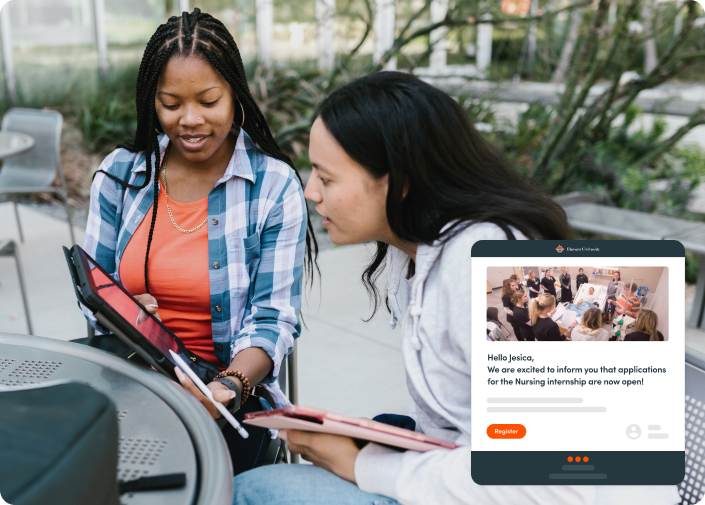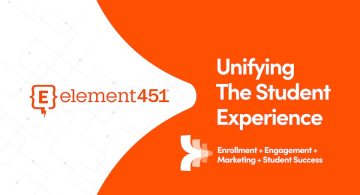What is Student Engagement in Higher Education?
by Sirley Carballo · Updated Jul 19, 2023

What is Student Engagement in Higher Education?
As we strive to improve experiences of modern students and learners, we often have to re-evaluate the intrinsic values that lead us to educating in the first place. Yes, there’s lots of glitz and glam with the latest student programs, facilities, and social offerings, but what happens when those things fail to improve the actual value you’re delivering to students?
Student engagement brings us “back to the basics.” It’s a way for those of us in higher education to improve relationships with students, deliver personalization, and make improvements that generate positive change for years to come.
Consider this your full-stop guide to modern student engagement. We’ll discuss its importance and relevance to the current higher ed climate and to school leaders, especially those tasked with improving low student engagement.
Defining Student Engagement—How to Keep Students Engaged
Student engagement can look like different things to many different people. In a higher education context, we tend to think of it in terms of the level (and quality) of encouragement that students receive throughout the student life cycle.
An engaged student or learner is one who actively participates in their educational journey. The engaged student finds relevance in their chosen field of study, connects their experiences to intended goals, and finds ways to become part of the broader community.
How do you truly know if your efforts are creating engagement in students? This depends on when and where the engagement happens. Prior to enrollment, it might be evidenced in the quality of conversations that the student has with an admissions counselor. Once enrolled, you might be able to identify tell-tale signs of healthy student engagement at your institution.
- The student is attending classes regularly and takes ownership of academic outcomes.
- Engaged students have in-depth questions about academic tasks, lessons, and discussions.
- An engaged student easily collaborates with their peers or other adults.
- There is tangible emotional engagement in how the student relates to school or to their own learning process.
- Engaged students are likely to have higher motivation with academic or extracurricular achievement.
What Happens Prior to Enrollment?
It’s important to note that most traditional student engagement metrics happen after a student is admitted and enrolled. But engaging students doesn’t just have to focus on their time in a classroom.
In fact, the pre-enrollment phase is one of the things that we focus on most at Element451. We know that in order to get students excited about attending, you have to make a bit of magic happen before they make a decision. That’s why we believe that student engagement also includes the following.
- Informed recruitment and admissions processes
- Personalized campaigns directed specifically to prospective students
- Individual attention based on a future student’s interests, needs, and goals
- Extra layers of support that make the admissions process feel simple

Experiencing the Benefits of Student Engagement in the Enrollment and Learning Process
Most colleges and universities hold the idea of student engagement in high esteem. That’s because engaged students offer numerous perks for the campus community. These benefits can include:
- Greater number of inquiring students at the recruitment stage
- More completed applications following traditional events and activities
- Enrolling students who are the right fit at particular institutions
- Enhanced student persistence and retention throughout an academic program
But to truly connect with your students in an intentional way (both before and after enrollment), school leaders must have clarity on potential hurdles. In today’s highly competitive student learning climate, the challenges facing higher education marketers are real and worthy of a close look.
Current Engagement Challenges
In a digital world, it may seem like behavioral engagement is easier than ever. But what many researchers and higher education leaders are discovering is that the gap between remote learning and in-person experiences is actually significant.
In a post-pandemic learning culture, schools must grapple with the challenges that could prevent them from reaching important engagement goals and giving students the emotional and cognitive resources they need.
- Fewer in-person recruiting activities
- Lack of internal staff or resources for recruitment and enrollment
- More online or hybrid options for digital classrooms
- Need to provide a “community of care” so that students have access to support
The takeaway here is this—excelling at engagement often means having in-depth knowledge of what student expectations are at every level, including admissions and enrollment. To achieve this, your school needs relevant and reliable student data.

Increase Student Engagement with Element451
Students want on-demand digital experiences and digital native touchpoints across the student journey. They want every message personalized for their unique needs. Do it all with Element451, the only higher-ed focused CRM.
See it in Action
Promote Student Engagement throughout the Student Journey
According to the Community College Survey of Student Engagement (CCSSE), well-established research on student engagement goes back several decades. As far back as the 1980s, higher education researchers were uncovering the value of student engagement both in admissions and in the classroom.
Although we now live in a highly digital world, some of the strategies and connection points to reach students remain the same. The focus is—and always has been—on ensuring that every student is equipped with the relationships, learning environment, and tools they need to succeed.
Strategies to Connect and Engage
If you’re looking for ways to improve your student connections this year, the first place to start is a thorough evaluation or audit of current practices. What are students saying about their personal enrollment or admissions processes? Are you aware of any major deficits or gaps in the current flow of activities? If so, tackle these areas first.
Then, you can move on to more targeted ways to enhance student engagement at your college or university.
- Offer multiple opportunities – When you work to engage with prospective students and families, remember to host several options for things like events, campus tours, admissions interviews, and any other recruitment opportunity. Diverse options allow you to cater to more students over time.
- Spend time with your audience – What is the biggest driver of traffic to your school’s website? How are students and families finding out about your academic programs? If it’s on social media, build a presence on different platforms to further engage and connect. The goal is to seize opportunities to be a part of the conversation, especially in areas where those talks are already taking place.
- Build community partnerships – To further engage, take time to establish your recruiting and enrollment network. Utilize local school systems (especially high schools or college preparatory academies), community organizations, and business partnerships. These relationships set students up with more opportunities to strengthen their bond to the campus and its major partners.
How to Measure Student Engagement (Develop a Deeper Understanding)
As is true with any big picture idea or strategy, you must take time to reflect and carefully analyze how things are going. It’s not enough to assume that your student population is engaged both before and after enrollment. Your team should expect to dig into the data (both quantitative and qualitative) to ensure that your processes are effective.
- Analyze the data in your CRM or engagement platform – When you utilize an engagement platform like Element451, you’ll have access to valuable analytics that help you measure the results of student contact. Consider how many students have responded to various marketing campaigns, where students are in the admissions funnel, and what the results are after enrollment.
- Ask for qualitative feedback – The clearest indicator of engagement rests with your students. Who else can tell you how they’re feeling about their academic journey at a given time? Whether you build automated surveys or schedule one-on-one interviews, it’s important to keep tabs on students’ sentiments and opinions. Qualitative feedback also enables you to improve specific touchpoints or offer targeted training to different members of your team.
- Gather student experience post-enrollment – While admissions data is valuable, it’s equally essential to check on students throughout their journey. Many personal and academic factors play a role in whether students proceed to graduation. Check in, offer resources, and follow-up—especially on any promises made during the initial admissions cycle.

Engagement vs. Personalization
Student engagement is your overarching plan for reaching students in meaningful ways. The ripple effects of engagement include increased enrollment, better alignment between school offerings and student goals, and greater participation in the classroom or community.
Personalization, on the other hand, involves the process of making new marketing messages or communications specific to certain students. Instead of a “one size fits all” approach, personalization means using individual student motivations as a way to improve the experience. This could be something as simple as delivering tailored content to a student who is interested in attending an MBA program in the future.
While the distinction is important, it’s also helpful to remember that engagement and personalization work in tandem to solve your school’s greatest goals. Engaged student populations are likely to have received some level of personalization, and vice versa.
Increase Student Engagement this Year
Student engagement can become a reality at your college or university. With the right strategies, plans, and resources, it’s possible to connect with your students on a deeper level.
Element451 can help you get there, with personalized campaigns and individualized experiences that set your school apart from the rest.
Let’s accomplish better recruitment, increased enrollment, and revamped college experiences.

About Element451
Boost enrollment, improve engagement, and support students with an AI workforce built for higher ed. Element451 makes personalization scalable and success repeatable.
Categories
New Blog Posts

The Definitive Guide
AI in Higher Education
Bridge the gap between the latest tech advancements and your institution's success.
Useful Links

Talk With Us
Element451 is the only AI Workforce Platform for higher education. Our friendly experts are here to help you explore how Element451 can improve outcomes for your school.
Get a Demo








